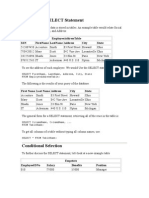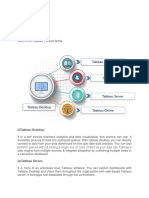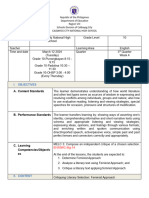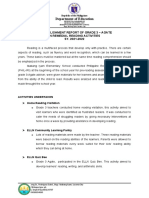Instructional System Design (ISD) : Using The ADDIE Model
Instructional System Design (ISD) : Using The ADDIE Model
Uploaded by
Fitrah PantoliCopyright:
Available Formats
Instructional System Design (ISD) : Using The ADDIE Model
Instructional System Design (ISD) : Using The ADDIE Model
Uploaded by
Fitrah PantoliOriginal Title
Copyright
Available Formats
Share this document
Did you find this document useful?
Is this content inappropriate?
Copyright:
Available Formats
Instructional System Design (ISD) : Using The ADDIE Model
Instructional System Design (ISD) : Using The ADDIE Model
Uploaded by
Fitrah PantoliCopyright:
Available Formats
Instructional System Design (ISD): Using the ADDIE Model
Instructional design is the systematic approach to the
Analysis, Design, Development, Implementation, and Evaluation of learning materials and activities.
Instructional design aims for a learner-centered rather than the traditional teacher-centered approach
to instruction, so that effective learning can take place. This means that every component of the
instruction is governed by the learning outcomes, which have been determined after a thorough analysis
of the learners’ needs.
These phases sometimes overlap and can be interrelated; however, they provide a dynamic,
flexible guideline for developing effective and efficient instruction.
Sample Tasks Sample Output
Analysis · Needs assessment · Learner profile
the process of defining what is to be · Problem identification · Description of constraints
learned · Task analysis · Needs, Problem Statement
· Task analysis
Design · Write objectives · Measurable objectives
the process of specifying how it is to · Develop test items · Instructional strategy
be learned · Plan instruction · Prototype specifications
· Identify resources
Development · Work with producers · Storyboard
the process of authoring and · Develop workbook, flowchart, · Script
producing the materials program · Exercises
· Computer assisted instruction
Implementation · Teacher training · Student comments, data
the process of installing the project in · Tryout
the real world context
Evaluation · Record time data · Recommendations
the process of determining the · Interpret test results · Project report
adequacy of the instruction · Survey graduates · Revised prototype
· Revise activities
San Jose State University, Instructional Technology Program
The ADDIE Model Analysis
is an iterative
instructional design
process, where the
results of the Design
formative evaluation
of each phase may Formative Evaluation
lead the instructional
designer back to any
previous phase. Development
The end product of
one phase is the
starting product of Implementation Summative Evaluation
the next phase.
Steven J. McGriff 09/2000
Instructional Systems, College of Education, Penn State University
Instructional System Design (ISD): Using the ADDIE Model
Analysis
The Analyze phase is the foundation for all other phases of instructional design. During this phase, you
must define the problem, identify the source of the problem and determine possible solutions.
The phase may include specific research techniques such as needs analysis, job analysis and task
analysis. The outputs of this phase often include the instructional goals, and a list of tasks to be
instructed. These outputs will be the inputs for the Design phase.
Design
The Design phase involves using the outputs from the Analyze phase to plan a strategy for developing the
instruction. During this phase, you must outline how to reach the instructional goals determined during
the Analyze phase and expand the instructional foundation.
Some of the elements of the Design Phase may include writing a target population description, conducting
a learning analysis, writing objectives and test items, selecting a delivery system, and sequencing the
instruction. The outputs of the Design phase will be the inputs for the Develop phase.
Development
The Develop phase builds on both the Analyze and Design phases. The purpose of this phase is to
generate the lesson plans and lesson materials. During this phase you will develop the instruction, all
media that will be used in the instruction, and any supporting documentation. This may include
hardware (e.g., simulation equipment) and software (e.g., computer-based instruction).
Implementation
The Implementation phase refers to the actual delivery of the instruction, whether it's classroom-based,
lab-based, or computer-based. The purpose of this phase is the effective and efficient delivery of
instruction. This phase must promote the students' understanding of material, support the students'
mastery of objectives, and ensure the students' transfer of knowledge from the instructional setting to the
job.
Evaluation
This phase measures the effectiveness and efficiency of the instruction. Evaluation should actually occur
throughout the entire instructional design process - within phases, between phases, and after
implementation. Evaluation may be Formative or Summative.
Formative Evaluation is ongoing during and between phases. The purpose of this type of evaluation
is to improve the instruction before the final version is implemented.
Summative Evaluation usually occurs after the final version of instruction is implemented. This type
of evaluation assesses the overall effectiveness of the instruction. Data from the Summative Evaluation is
often used to make a decision about the instruction (such as whether to purchase an instructional package
or continue/discontinue instruction).
This ADDIE Model descriptive summary was provided by three Graduate Students (Sherri Braxton,
Kimberly Bronico, Thelma Looms) in the Computer Science Department at The George
Washington University in Washington, D.C. Available as of 9/23/00 at:
http://www.seas.gwu.edu/~sbraxton/ISD/general_phases.html
Steven J. McGriff 09/2000
Instructional Systems, College of Education, Penn State University
You might also like
- PYP Planner For 'Who We Are'Document4 pagesPYP Planner For 'Who We Are'KerisseL100% (4)
- Common Analytics Interview QuestionsDocument4 pagesCommon Analytics Interview QuestionsPKDBNo ratings yet
- Lesson Plan Parallel Lines Cut by A TransversalDocument2 pagesLesson Plan Parallel Lines Cut by A Transversalapi-534095936No ratings yet
- Lesson Plan 11Document3 pagesLesson Plan 11Fatima ObaidNo ratings yet
- ADDIEDocument2 pagesADDIEAlyssa BuenavistaNo ratings yet
- Teaching Talk Instructional DesignDocument43 pagesTeaching Talk Instructional Designapi-399296437No ratings yet
- The ADDIE ModelDocument6 pagesThe ADDIE ModelFatma ZidanNo ratings yet
- Instructional Design (ADDIE)Document8 pagesInstructional Design (ADDIE)Esther HamiltonNo ratings yet
- What Is Isd..: Instructional Systems DesignDocument29 pagesWhat Is Isd..: Instructional Systems DesignFairuzSamsudinNo ratings yet
- SQL TutorialDocument28 pagesSQL TutorialDikson Pratama ManjinNo ratings yet
- Id ModelDocument26 pagesId ModelAura AurumNo ratings yet
- Basic PowerPointDocument2 pagesBasic PowerPointPrithvi NarvekarNo ratings yet
- Week 10-Training and DevelopmentDocument27 pagesWeek 10-Training and DevelopmentMazin MostafaNo ratings yet
- SQL (Part 5)Document6 pagesSQL (Part 5)bookworm_shashiNo ratings yet
- Training and Development: Managing Human ResourcesDocument60 pagesTraining and Development: Managing Human ResourcesKrishma BarotNo ratings yet
- ADDIE Model: Analysis PhaseDocument2 pagesADDIE Model: Analysis PhaseNimSha NimzzNo ratings yet
- Addie Model: Analysis PhaseDocument2 pagesAddie Model: Analysis PhaseAVIJIT SENNo ratings yet
- Tablue Et GoDocument16 pagesTablue Et GoKranti KumarNo ratings yet
- Zoraida Rosado Instructional Design ResumeDocument2 pagesZoraida Rosado Instructional Design ResumeZoraida RosadoNo ratings yet
- Introduction To Microsoft Powerpoint 2007Document65 pagesIntroduction To Microsoft Powerpoint 2007mary joyce enocNo ratings yet
- Senior Instructional Designer in Baltimore MD Resume Suzanne DizDocument2 pagesSenior Instructional Designer in Baltimore MD Resume Suzanne DizSuzanne DizNo ratings yet
- Statistics For Data AnalysisDocument13 pagesStatistics For Data Analysisعبد الحقNo ratings yet
- Behavioral Qna: Mazher Khan - Iit (Bhu) - B.Tech (Dr-2)Document12 pagesBehavioral Qna: Mazher Khan - Iit (Bhu) - B.Tech (Dr-2)surajNo ratings yet
- Chapter 1 Data AnalysisDocument18 pagesChapter 1 Data AnalysisGahnzelle Eidref FerreriaNo ratings yet
- 2017 - Sarstedt Et Al. - Handbook of Market Research PDFDocument41 pages2017 - Sarstedt Et Al. - Handbook of Market Research PDFF Cristina QueirozNo ratings yet
- How To Write A Data Analyst Job DescriptionDocument2 pagesHow To Write A Data Analyst Job DescriptionSorina VlaicuNo ratings yet
- Statistics For Data AnalysisDocument7 pagesStatistics For Data Analysisdhananjaya.geoNo ratings yet
- My Excel BookDocument50 pagesMy Excel BookUmair SaeedNo ratings yet
- Power BI Case Study Meta Data Sheet-2Document1 pagePower BI Case Study Meta Data Sheet-2Komi David ABOTSITSENo ratings yet
- Job Analysis & Job DesignDocument13 pagesJob Analysis & Job DesignprabhsimranNo ratings yet
- Addie ModelDocument2 pagesAddie ModelPutra AftusNo ratings yet
- Project On: Training and DevelopmentDocument16 pagesProject On: Training and DevelopmentMadhu MathiNo ratings yet
- Guide To Making Great PresentationsDocument25 pagesGuide To Making Great PresentationsGNo ratings yet
- Top Data Analyst Interview QuestionsDocument28 pagesTop Data Analyst Interview QuestionsAlferino FilhoNo ratings yet
- CHP 7 Traditional Training MethodsDocument26 pagesCHP 7 Traditional Training MethodsNawshin HuqNo ratings yet
- Data Analyst Job DescriptionDocument16 pagesData Analyst Job DescriptionjannatbluebirdNo ratings yet
- Python 1Document15 pagesPython 1Swapnarani SahooNo ratings yet
- AgileMania BookDocument27 pagesAgileMania BookBinod KhatriNo ratings yet
- Quantitative Techniques & Operations Research: Ankit Sharma Neha Rathod Suraj Bairagi Vaibhav ThammanDocument12 pagesQuantitative Techniques & Operations Research: Ankit Sharma Neha Rathod Suraj Bairagi Vaibhav ThammanAbhijeet SinghNo ratings yet
- MS Excel Workshop - One Day TrainingDocument11 pagesMS Excel Workshop - One Day Trainingm60347406No ratings yet
- Yelp Data CourseraDocument14 pagesYelp Data CourseraMurali ReddyNo ratings yet
- Designing and Planning Technology Enhanced InstructionDocument19 pagesDesigning and Planning Technology Enhanced Instructionboi83No ratings yet
- Be Future Opportunities? Although, There Are Various Worthwhile Career Opportunities AfterDocument2 pagesBe Future Opportunities? Although, There Are Various Worthwhile Career Opportunities AfterYash SinghNo ratings yet
- Workshop: Intermediate 3 Data Science: Image Processing On R and PythonDocument3 pagesWorkshop: Intermediate 3 Data Science: Image Processing On R and PythonHeru Wiryanto100% (1)
- PowerPoint Advance MyAnuarDocument3 pagesPowerPoint Advance MyAnuarNurul AfizaNo ratings yet
- Matrix-Vector Multiplication Using MapReduce in Big Data.Document4 pagesMatrix-Vector Multiplication Using MapReduce in Big Data.Pallavi giraseNo ratings yet
- 2nd Unit - 2.2 - Data AnalyticsDocument22 pages2nd Unit - 2.2 - Data AnalyticsAkshay VkNo ratings yet
- Assignment 4 - Research ProposalDocument4 pagesAssignment 4 - Research ProposalSyed Kaleem GilaniNo ratings yet
- Resume 1Document3 pagesResume 1rockstaryashwant9876No ratings yet
- Data AnalysisDocument17 pagesData AnalysisHillary MurungaNo ratings yet
- Identifying New Product Development Best PracticeDocument13 pagesIdentifying New Product Development Best Practiceaulios100% (1)
- Customer Churn PredictionDocument18 pagesCustomer Churn Predictionradhin100% (1)
- 1-Introduction SQL ServerDocument66 pages1-Introduction SQL ServerRana GaballahNo ratings yet
- Exploratory Data AnalysisDocument209 pagesExploratory Data AnalysisChaitanya Krishna Deepak100% (1)
- Training Roadmap Graphic Designer - FinalDocument5 pagesTraining Roadmap Graphic Designer - FinalSunil KumarNo ratings yet
- The Triple Constraints ExplainedDocument1 pageThe Triple Constraints Explainednuraina aqilah100% (1)
- A Review On Decision-Making Methods in Engineering Design For The Automotive IndustryDocument27 pagesA Review On Decision-Making Methods in Engineering Design For The Automotive IndustryNejib GhazouaniNo ratings yet
- Analyzing IoT Data in Python Chapter2Document35 pagesAnalyzing IoT Data in Python Chapter2FgpeqwNo ratings yet
- Conditional Formatting in Pivot Tables - GoodlyDocument10 pagesConditional Formatting in Pivot Tables - GoodlyKen NethNo ratings yet
- Business AnalyticsDocument9 pagesBusiness AnalyticsArjun TrehanNo ratings yet
- Instructional System Design (ISD) : Using The ADDIE ModelDocument3 pagesInstructional System Design (ISD) : Using The ADDIE ModelYOGA PRATAMANo ratings yet
- 5 +addie-1Document2 pages5 +addie-1Diwa SaadNo ratings yet
- Lesson 13 ADDIE ModelDocument21 pagesLesson 13 ADDIE Modelabcdefg690700No ratings yet
- Dll-8-2-Multiplication and Division of Rational Algebraic ExpressionDocument9 pagesDll-8-2-Multiplication and Division of Rational Algebraic ExpressionHero MirasolNo ratings yet
- Kanhere Thesis 2023Document74 pagesKanhere Thesis 2023Gurmehak kaurNo ratings yet
- Roles of Educational TechnologyDocument43 pagesRoles of Educational TechnologyBhyu Jin HyunNo ratings yet
- AI OmanDocument9 pagesAI OmandijayNo ratings yet
- Proceedings ICCIT 09Document298 pagesProceedings ICCIT 09arfankafNo ratings yet
- Slide Presentation - Social ConstructivistDocument28 pagesSlide Presentation - Social ConstructivistmissdeebNo ratings yet
- DLL Mapeh-1 Q1 W6Document2 pagesDLL Mapeh-1 Q1 W6Ranjell Allain Bayona Torres100% (1)
- Learner-Centered Teaching (Presentation of Maryellen Weimer's Book)Document30 pagesLearner-Centered Teaching (Presentation of Maryellen Weimer's Book)Лана ШаманаеваNo ratings yet
- Integrating Deep Reinforcement Learning With Model-Based Path PlannerDocument6 pagesIntegrating Deep Reinforcement Learning With Model-Based Path PlannerAdnan HossainNo ratings yet
- Kahoot Lesson PlanDocument2 pagesKahoot Lesson Planapi-497473925No ratings yet
- BPT1501 Assignment 05Document4 pagesBPT1501 Assignment 05Vincentius KrigeNo ratings yet
- DLP For Feminist ApproachDocument11 pagesDLP For Feminist ApproachAnaliza IglesiasNo ratings yet
- Summary - Nguyễn Khánh Linh - 1815520193Document3 pagesSummary - Nguyễn Khánh Linh - 1815520193KankanNguyenNo ratings yet
- Matarba Primary School SIPDocument27 pagesMatarba Primary School SIPHaron HB WritersNo ratings yet
- Machine Learning With PythonDocument487 pagesMachine Learning With PythonWarnet DALNETNo ratings yet
- Group 8 Chap 10 Leading ChangeDocument37 pagesGroup 8 Chap 10 Leading Changeloc1409No ratings yet
- Bridging The Gap Between Second Language Acquisition Research and Memory Science: The Case of Foreign Language AttritionDocument8 pagesBridging The Gap Between Second Language Acquisition Research and Memory Science: The Case of Foreign Language AttritionCharlene OliverosNo ratings yet
- InformerDocument2 pagesInformerHarris KianiNo ratings yet
- 8765 57813 2 PB2Document25 pages8765 57813 2 PB2Tiago G. SantosNo ratings yet
- "DINO vs. DINI" Educational Game To Increase Children's Cognitive Abilities-What Are Its Level Elements?Document6 pages"DINO vs. DINI" Educational Game To Increase Children's Cognitive Abilities-What Are Its Level Elements?International Journal of Assyfa ResearchNo ratings yet
- Individual Plan For Professional Development (PPD)Document25 pagesIndividual Plan For Professional Development (PPD)Queenie ButalidNo ratings yet
- ACCOMPLISHMENT REPORT OF GRADE 3-ReadingDocument2 pagesACCOMPLISHMENT REPORT OF GRADE 3-ReadingMaam Riza Sasot100% (4)
- Lesson Plan in Media and Information Literacy: (Have A Brief Description)Document7 pagesLesson Plan in Media and Information Literacy: (Have A Brief Description)Dandreb SardanNo ratings yet
- Performance Appraisal Form: Submitted By: Irfan Ahmad ChatthaDocument3 pagesPerformance Appraisal Form: Submitted By: Irfan Ahmad Chatthairfan1982No ratings yet
- Application of Chemical ReactionsDocument4 pagesApplication of Chemical ReactionsIrvin Ecalnir0% (1)
- Buck (2001:104) Identifies Two Kinds of Strategies in ListeningDocument3 pagesBuck (2001:104) Identifies Two Kinds of Strategies in ListeningKaren ManioNo ratings yet
- Developmental Lesson PlanDocument8 pagesDevelopmental Lesson PlanAmber ShookNo ratings yet

























































































